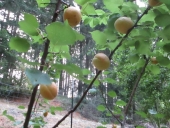Judith Browning wrote:
M.K. Dorje Sr. wrote:That last one is definitely some kind of Amanita, probably in the Lepidella subgroup that includes several deadly species. Almost very year inexperienced people mistake Amanita mushrooms for edibles like the White Matsutake with fatal results. Like my mycology teacher used to say- "When in doubt, throw it out."
that's what I thought....I need to label the photo.
Without a definite ID what would you suggest?
Usually I try to take a gill photo but for this one I didn:t want my phone anywhere close to it!
If I'm at all in doubt I don't touch them.
Me too! There are several species of Amanita in the Lepidella subgroup in the southeastern US that are difficult to ID down to species without a microscope. In Oregon, there's one called Smith's Amanita that can look similar to the White Matsutake and sometimes grows right next to them- maybe that confusion is causing the poisonings in California. Anyway, I always avoid any mushroom with a cup or bulb at the base, white gills and a white spore print.
Judith, I also enjoy all these photos from your field trips. In the 1990s I wanted to travel to the swamps in Arkansas and see an Ivory-Billed Woodpecker- the holy grail of American bird watching.









